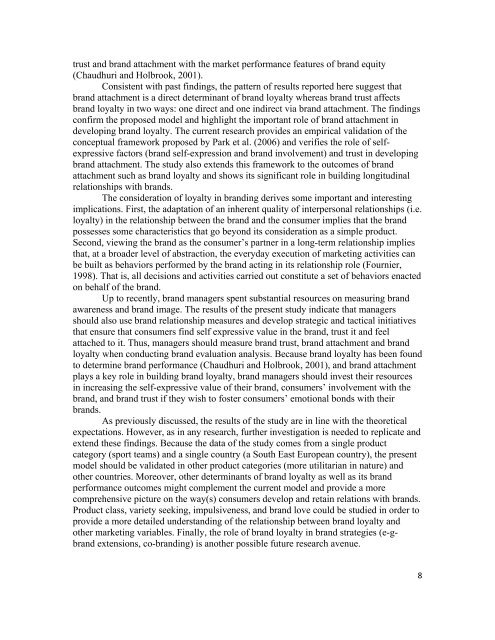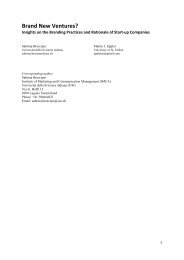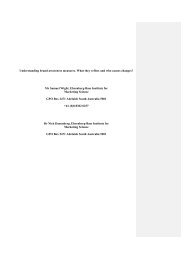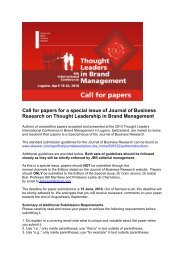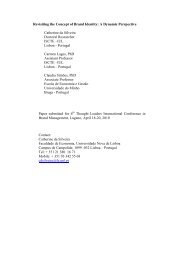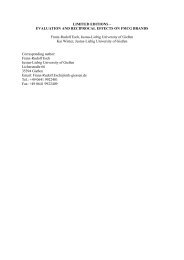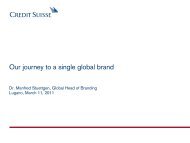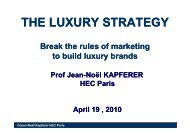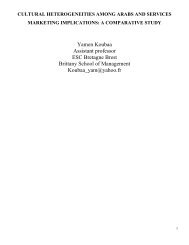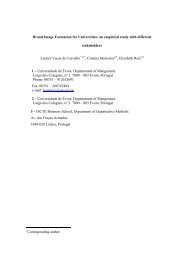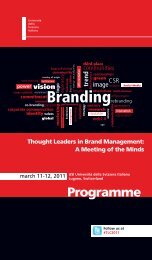Brand Loyalty through Brand Attachment and Brand Trust - Thought ...
Brand Loyalty through Brand Attachment and Brand Trust - Thought ...
Brand Loyalty through Brand Attachment and Brand Trust - Thought ...
Create successful ePaper yourself
Turn your PDF publications into a flip-book with our unique Google optimized e-Paper software.
trust <strong>and</strong> br<strong>and</strong> attachment with the market performance features of br<strong>and</strong> equity<br />
(Chaudhuri <strong>and</strong> Holbrook, 2001).<br />
Consistent with past findings, the pattern of results reported here suggest that<br />
br<strong>and</strong> attachment is a direct determinant of br<strong>and</strong> loyalty whereas br<strong>and</strong> trust affects<br />
br<strong>and</strong> loyalty in two ways: one direct <strong>and</strong> one indirect via br<strong>and</strong> attachment. The findings<br />
confirm the proposed model <strong>and</strong> highlight the important role of br<strong>and</strong> attachment in<br />
developing br<strong>and</strong> loyalty. The current research provides an empirical validation of the<br />
conceptual framework proposed by Park et al. (2006) <strong>and</strong> verifies the role of selfexpressive<br />
factors (br<strong>and</strong> self-expression <strong>and</strong> br<strong>and</strong> involvement) <strong>and</strong> trust in developing<br />
br<strong>and</strong> attachment. The study also extends this framework to the outcomes of br<strong>and</strong><br />
attachment such as br<strong>and</strong> loyalty <strong>and</strong> shows its significant role in building longitudinal<br />
relationships with br<strong>and</strong>s.<br />
The consideration of loyalty in br<strong>and</strong>ing derives some important <strong>and</strong> interesting<br />
implications. First, the adaptation of an inherent quality of interpersonal relationships (i.e.<br />
loyalty) in the relationship between the br<strong>and</strong> <strong>and</strong> the consumer implies that the br<strong>and</strong><br />
possesses some characteristics that go beyond its consideration as a simple product.<br />
Second, viewing the br<strong>and</strong> as the consumer’s partner in a long-term relationship implies<br />
that, at a broader level of abstraction, the everyday execution of marketing activities can<br />
be built as behaviors performed by the br<strong>and</strong> acting in its relationship role (Fournier,<br />
1998). That is, all decisions <strong>and</strong> activities carried out constitute a set of behaviors enacted<br />
on behalf of the br<strong>and</strong>.<br />
Up to recently, br<strong>and</strong> managers spent substantial resources on measuring br<strong>and</strong><br />
awareness <strong>and</strong> br<strong>and</strong> image. The results of the present study indicate that managers<br />
should also use br<strong>and</strong> relationship measures <strong>and</strong> develop strategic <strong>and</strong> tactical initiatives<br />
that ensure that consumers find self expressive value in the br<strong>and</strong>, trust it <strong>and</strong> feel<br />
attached to it. Thus, managers should measure br<strong>and</strong> trust, br<strong>and</strong> attachment <strong>and</strong> br<strong>and</strong><br />
loyalty when conducting br<strong>and</strong> evaluation analysis. Because br<strong>and</strong> loyalty has been found<br />
to determine br<strong>and</strong> performance (Chaudhuri <strong>and</strong> Holbrook, 2001), <strong>and</strong> br<strong>and</strong> attachment<br />
plays a key role in building br<strong>and</strong> loyalty, br<strong>and</strong> managers should invest their resources<br />
in increasing the self-expressive value of their br<strong>and</strong>, consumers’ involvement with the<br />
br<strong>and</strong>, <strong>and</strong> br<strong>and</strong> trust if they wish to foster consumers’ emotional bonds with their<br />
br<strong>and</strong>s.<br />
As previously discussed, the results of the study are in line with the theoretical<br />
expectations. However, as in any research, further investigation is needed to replicate <strong>and</strong><br />
extend these findings. Because the data of the study comes from a single product<br />
category (sport teams) <strong>and</strong> a single country (a South East European country), the present<br />
model should be validated in other product categories (more utilitarian in nature) <strong>and</strong><br />
other countries. Moreover, other determinants of br<strong>and</strong> loyalty as well as its br<strong>and</strong><br />
performance outcomes might complement the current model <strong>and</strong> provide a more<br />
comprehensive picture on the way(s) consumers develop <strong>and</strong> retain relations with br<strong>and</strong>s.<br />
Product class, variety seeking, impulsiveness, <strong>and</strong> br<strong>and</strong> love could be studied in order to<br />
provide a more detailed underst<strong>and</strong>ing of the relationship between br<strong>and</strong> loyalty <strong>and</strong><br />
other marketing variables. Finally, the role of br<strong>and</strong> loyalty in br<strong>and</strong> strategies (e-gbr<strong>and</strong><br />
extensions, co-br<strong>and</strong>ing) is another possible future research avenue.<br />
8


